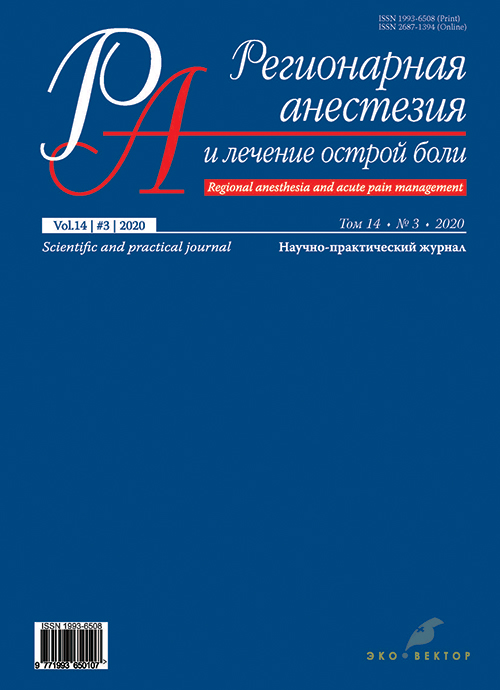Postoperative anesthesia for vitreoretinal surgery in children
- Authors: Oleshchenko I.G.1, Zabolotskii D.V.2, Iureva T.N.1, Zaika V.A.1, Koriachkin V.A.2
-
Affiliations:
- Irkutsk Branch of S.N. Fyodorov Eye Microsurgery Federal State Institution of Ministry of Health of the Russian Federation
- Saint-Petersburg State Pediatric Medical University of Ministry of Health of the Russian Federation
- Issue: Vol 14, No 3 (2020)
- Pages: 156-163
- Section: Original articles
- URL: https://bakhtiniada.ru/1993-6508/article/view/57663
- DOI: https://doi.org/10.17816/1993-6508-2020-14-3-156-163
- ID: 57663
Cite item
Abstract
Vitreoretinal surgery for retinal detachments in children is an effective, sometimes the only method to restore vision. As practice shows, the use of minimally invasive regional techniques is increasingly used for combined anesthesia in ophthalmic surgery in children. In the postoperative period, the use of blockades can provide prolonged analgesia, thereby improving the child’s comfort level after the surgery. All types of blockades in ophthalmology have certain risks, but the pterygopalatine blockade has not any, since it is performed outside the eye structures. The research of the use of the pterygopalatine blockade after surgery in children is important not only for creating prolonged analgesia, but also for reducing vegetative reactions that can complicate the recovery period.
Purpose of the study is to increase the pain management efficacy in the postoperative period in children who have undergone extensive surgery for retinal detachment.
Materials and methods. 1st group (n = 32) received postoperative analgesia — pterygopalatine blockage with ropivacaine 0.5%, 2nd group (n = 28) — systemic analgesia. Changes in hemodynamics and stress index in the postoperative period were evaluated. Cortisol levels in the intensive care unit was evaluated in 2 hours later. The time and frequency use of antiemetics in the occurrence of PONV were recorded. The level of patients comfort after surgery and the pain intensity were evaluated on an integral scale and on the Verbal Rating Scale (VRS) in points.
Results. The children of 1st group did not have significant changes in heart rate and SBP in the intensive care unit. In group 1, the TI decreased by 13.2% in the intensive care unit, and in group 2, the TI increased by 28.5% after 2 hours and by 88.6% after 8 hours. 2 hours after the surgery pain was 2 points in 12.5% of the patients (1st group) and 39.2% of patients (2nd group). After 8 hours, 35.7% of patients (2nd group) reported moderate pain that required medication. There were no PONV in group 1, and it occured in 28.5% of patients in group 2. In group 1, 75% of children rated the postoperative period as comfortable, and in group 2 — 21.4% (p < 0,05).
Conclusion. Pterygopalatine blockade as the main method of postoperative analgesia in the early postoperative period has got a long-term analgesic effect, reducing the frequency of nausea and vomiting, improving the quality of the postoperative period in children.
Full Text
##article.viewOnOriginalSite##About the authors
I. G. Oleshchenko
Irkutsk Branch of S.N. Fyodorov Eye Microsurgery Federal State Institution of Ministry of Health of the Russian Federation
Author for correspondence.
Email: iga.oleshenko@mail.ru
ORCID iD: 0000-0003-1642-5276
MD, PhD, anesthesiologist of department of anesthesiology
Russian Federation, IrkutskD. V. Zabolotskii
Saint-Petersburg State Pediatric Medical University of Ministry of Health of the Russian Federation
Email: iga.oleshenko@mail.ru
ORCID iD: 0000-0002-6127-0798
Russian Federation, Saint-Petersburg
T. N. Iureva
Irkutsk Branch of S.N. Fyodorov Eye Microsurgery Federal State Institution of Ministry of Health of the Russian Federation
Email: iga.oleshenko@mail.ru
ORCID iD: 0000-0003-0547-7521
Russian Federation, Irkutsk
V. A. Zaika
Irkutsk Branch of S.N. Fyodorov Eye Microsurgery Federal State Institution of Ministry of Health of the Russian Federation
Email: iga.oleshenko@mail.ru
ORCID iD: 0000-0001-9100-1751
Russian Federation, Irkutsk
V. A. Koriachkin
Saint-Petersburg State Pediatric Medical University of Ministry of Health of the Russian Federation
Email: iga.oleshenko@mail.ru
ORCID iD: 0000-0002-3400-8989
Russian Federation, Saint-Petersburg
References
- Nuzzi R, Lavia C, Spinetta R. Paediatric retinal detachment: a review. Int. J. Ophthalmol. 2017;10(10):1592–11. doi: 10.18240/ijo.2017.10.18.
- Bobrovoy NF. Pediatric ophthalmology. [Detskaya oftal’mologiya.] Moscow: GEOTAR — Media; 2003. (In Russ).
- Ivlev YeV, Boyko YeA, Ruban YeA, Butov OV, Grigor’yev YeV. Preemptive analgesia in combination with multicomponent General anesthesia in children during operations in the nasal cavity and nasopharynx. Anesteziologiya i reanimatologiya. 2015;60(6):46–3. (In Russ).
- Snidvongs S, Nagaratnam M, Stephens R. Assessment and treatment of pain in children. Br. J. Hosp. Med. 2008;69(4):211–3. doi: 10.12968/hmed.2008.69.4.28975.
- Hamilton RC. Technique of ocular regional anesthesia. Can. Anesthesiol. 1992;40(7):463-5. PMID: 1477766.
- Efficacy of sphenopalatine ganglion block in nasal mucosal headache presenting as facial pain. Cranio. 2020;38(2):128–30. 2018;8:1–3. DOI: 10.1080/ 08869634.2018.1475859.
- Mehta D, Leary MC, Yacoub HA et al. The effect of regional anesthetic sphenopalatine ganglion block on self-reported pain in patients with status migrainosus. Headache. 2019;59(1):69–7. doi: 10.1111/head.13390.
- Oleshchenko I, Cok OY, Iureva T, Zabolotskii D, Kripak A. Effect of pterygopalatine blockade on perioperative stress and inflammatory outcomes following paediatric cataract surgery. Reg. Anesth. Pain. Med. 2020;45(3):204–4. doi: 10.1136/rapm-2019-100823.
- Ebbeling MB, Oomen KP, de Ru JA et al. Neurochemical characterization of pterygopalatine ganglion branches in humans. Am. J. Rhinol. Allergy. 2011;25(1):50–3. doi: 10.2500/ajra.2012.26.3697.
- Ul’rikh GE, Zabolotskiy DV. Postoperative anesthesia in children. What standards should we use? Regionarnaya anesteziya i lecheniye ostroy boli. 2015;2:40–5. (In Russ).
- Molchanov IV. Prolonged analgesia with ropivacaine after surgery on the thyroid gland. Vestnik Rossiyskogo nauchnogo tsentra rentgenoradiologii Minzdrava Rossii. 2013;4(13):13. (In Russ).
- Myles PS. Patient satisfaction after anaesthesia and surgery: results of a prospective survey of 10,811 patients. British journal of anaesthesia. 2000;84(1):6–10. doi: 10.1093/oxfordjournals.bja.a013383.
- Kranke P, Eberhart LH. Possibilities and limitations in the pharmacological management of postoperative nausea and vomiting. European Journal of Anaesthesiology. 2011;28(11):758–7. doi: 10.1097/EJA.0b013e32834a4e1e.
Supplementary files










